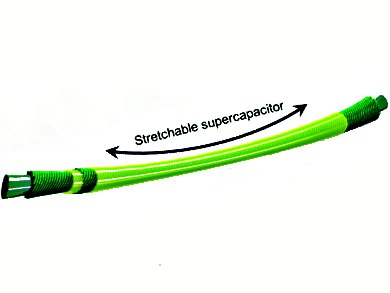Highly Stretchable Fiber-Shaped Supercapacitor
A mobile telephone display for your jacket sleeve, ECG probes for your workout clothes—wearable electronics are in demand. In order for textiles with built-in electronics to function over longer periods of time, all of the components need to be flexible and stretchable. In the journal Angewandte Chemie, Chinese researchers have now introduced a new type of supercapacitor that fulfills this requirement. Its components are fiber-shaped and based on carbon nanotubes.
For electronic devices to be incorporated into textiles or plastic films, their components must be stretchable. This is true for LEDS, solar cells, transistors, circuits, and batteries—as well as for the supercapacitors often used for static random access memory (SRAM). SRAM is often used as a cache in processors or for local storage on chips, as well as in devices that must maintain their data over several years with no source of power.
Previous stretchable electronic components have generally been produced in a conventional planar format, which has been an obstacle to their further development for use in small, lightweight, wearable electronics. Initial attempts to produce supercapacitors in the form of wires or fibers produced flexible—but not stretchable—components. However, stretchability is a required feature for a number of applications. For example, electronic textiles would easily tear if they were not stretchable.
New Family of Supercapacitors
A team led by Huisheng Peng at Fudan University has now developed a new family of highly stretchable, fiber-shaped, high-performance supercapacitors. The devices are made by a winding process with an elastic fiber at the core. The fiber is coated with an electrolyte gel and a thin layer of carbon nanotubes is wound around it like a sheet of paper. This is followed by a second layer of electrolyte gel, another layer of carbon nanotube wrap, and a final layer of electrolyte gel.
The delicate “sheets” of carbon nanotubes are produced by chemical vapor deposition (CVD) and a spinning process. In the sheets this method produces, the tiny tubes are aligned in parallel. These types of layers display a remarkable combination of properties: They are highly flexible, tear-resistant, conductive, and thermally and mechanically stable. In the wound fibers, the two layers of carbon nanotubes act as electrodes. The electrolyte gel separates the electrodes from each other while stabilizing the nanotubes during stretching so that their alignment is maintained. This results in supercapacitor fibers with a high capacity that is maintained after many stretching cycles.
- A Highly Stretchable, Fiber-Shaped Supercapacitor,
Zhibin Yang, Jue Deng, Xuli Chen, Jing Ren, Huisheng Peng,
Angew. Chem. Int. Ed. 2013.
DOI: 10.1002/anie.201307619




